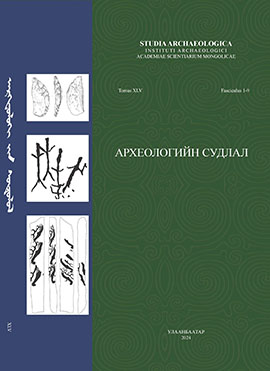Identification of animal anklebones (astragalus) discovered from Xiongnu and Xianbei period graves
DOI:
https://doi.org/10.5564/sa.v45i2.3784Keywords:
Anklebone, astragalus, children’s games, toy, Xiongnu, XianbeiAbstract
Animal anklebones (also known as the astragalus) were one of the oldest gaming pieces of the ancient world, and research shows these have been used for at least 5000 years by the pastoral herders in Inner Asian steppe. In Mongolia, the oldest such examples of this practice date to the Early Bronze Age (3rd millennium BC). During the Xiongnu period (3rd century BC to 1st century AD) of ancient Mongolia, anklebones were commonly found in children’s burials, but the exact species of the bones found in these burials have yet to be identified. In this article, I present the zooarchaeological identification of 500 ankle bones found in 5 burials of the Xiongnu and Xianbei periods, comparing them to both wild and domestic taxa. Result showed sheep (Ovis aries) predominate in the anklebone assemblages, with few goat (Capra hircus), and a small percentage of wild taxa such as roe deer (Capreolus pygargus), gazella (Procapra gutturosa), argali sheep (Ovis ammon) and ibex (Capra sibirica pallas) account for a certain percentage. Results also show that during the Xiongnu and Xianbei periods, the anklebones were flattened, perforated (hole), decorated with incised carvings, and some even hollowed out or cast in metal, suggesting that the bones might have been used to play a variety of games.
Хүннү, сяньбигийн үеийн булшнаас илэрсэн шагайн төрөл зүйлийн судалгаа
Хураангуй: Хүмүүс эрт үеэс мал, амьтны яс тэр дундаа шагайн ясыг дүрсжүүлэн тоглож ирсэн уламжлалтай. Дотоод Азийн хэмжээнд лавтай 5000 жилийн тэртээгээс шагайгаар тоглож ирсэн баримт байх ч чухам ямар төрлийн мал, амьтны шагайгаар тоглож байсныг тодорхойлсон судалгаа ховор юм. Харин энэхүү өгүүлэлд хүннү, сяньбигийн үеийн 5 булшнаас илэрсэн 500 шагайд хийсэн судалгааны үр дүнг нийтэлж буй бөгөөд хонь, ямааны шагайг ялгаж таних монголчуудын уламжлалт арга болон зэрлэг амьтдын шагайн цуглуулгад үндэслэн мал, амьтны төрөл зүйлийг тодорхойлов. Судалгааны үр дүнгээс үзвэл хонины шагай илт давамгайлж, эсрэгээр ямааны шагай маш цөөн тоотой, харин гөрөөс, зээр, аргаль, янгир зэрэг ан амьтдын шагай тодорхой хувийг эзэлж байна. Хүннү, сяньбигийн үед шагайг нүхэлсэн, хавтгайлсан, тамга тэмдэг сийлбэрлэсэн, түүгээр зогсохгүй зарим шагайн дотор талыг хөндийлж ухсан, төмөр цутгасан зэрэг баримтууд илэрсэн нь шагайн тоглоомын хэлбэр зүйл, онцлогийг илтгэж буй бололтой.
Түлхүүр үг: Шагай, тоглоом, наадгай, нүхтэй шагай, сийлбэртэй шагай, хүннү, сяньби
Downloads
555
Downloads
Published
How to Cite
Issue
Section
License
Copyright (c) 2024 Tuvshinjargal Tumurbaatar

This work is licensed under a Creative Commons Attribution-NonCommercial 4.0 International License.
Copyright on any research article in the Studia archeologica is retained by the author(s).
The authors grant the Studia archeologica license to publish the article and identify itself as the original publisher.
![]()
Articles in the Studia archeologica are Open Access articles published under a Creative Commons Attribution-NonCommercial 4.0 International License - CC BY NC.
This license permits use, distribution and reproduction in any medium, provided the original work is properly cited.




